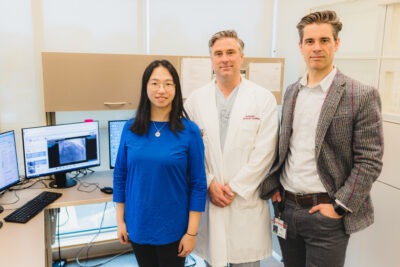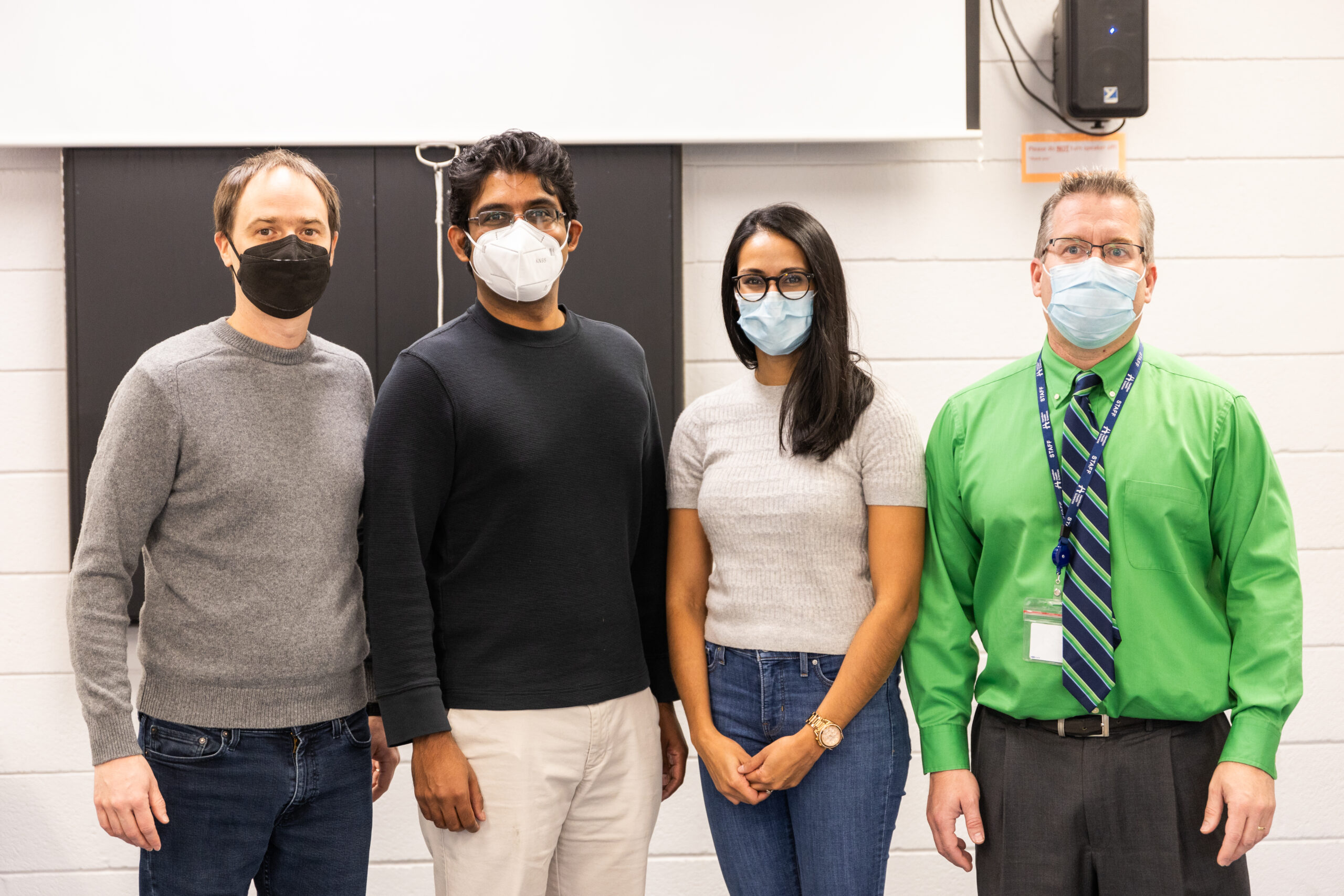
Using AI to help cardiac patients find the best test/treatment
A new Hamilton Health Sciences (HHS) study will harness the power of artificial intelligence (AI) to help determine which cardiac patients need an invasive procedure to check for life-threatening artery blockages to the heart, and which patients who would benefit from a simpler, non-invasive test using CT scanning.
The two-year randomized control trial, where participants are assigned into the research study group or a control group, is expected to launch in June and involve up to 150 patients from HHS Hamilton General Hospital (HGH) and Niagara Health’s St. Catharines Hospital site.

Data scientist Shuang Di, Dr. J.D. Schwalm and Dr. Jeremy Petch
“Very few randomized control trials of AI are happening in health care, so this is considered a landmark study,” says Dr. J.D. Schwalm, an interventional cardiologist at HGH and director of HHS’ Centre for Evidence-Based Implementation (CEBI), established to advance health care through research and education. CEBI partnered with HHS Centre for Data Science and Digital Health (CREATE) for this trial, and research leading up to it. The trial received funding from Hamilton Academic Health Sciences Organization and the Population Health Research Institute, a joint institute of HHS and McMaster University.
Based on previous research including a study of patient data going back 12 years, this AI tool is expected to be faster and better at ensuring patients are directed to the best test for their condition. For example, the AI tool will recommend patients for an invasive coronary angiogram if they have a higher chance of blockage in their heart arteries based on their medical information. The AI tool can also identify patients who likely don’t have a blockage, and will recommend them for CT scanning. This tool has the potential to improve patient outcomes, advance health equity and lower the cost of health care.
“Ultimately we want to scale this AI tool provincially, if we can prove through this latest study that it delivers what we believe it can,” says Schwalm, adding that the team is also in the process of validating this model at the provincial level with data from ICES, an independent, non-profit research corporation.
Driving system efficiencies
“The province, in its Auditor General report, found that there’s a need for system-level improvements to ensure patients don’t undergo unnecessary and costly treatments,” says Dr. Ted Scott, HHS vice president of innovation and partnerships. “This new trial, and the work leading up to it, illustrate the power of AI when it is implemented using evidence-based methods to improve patient care and drive system efficiencies.”

Dr. Ted Scott
An invasive coronary angiogram procedure is considered the gold standard for diagnosing coronary artery disease, caused when vessels supplying blood to the heart get narrowed, clogged or completely blocked by plaque. It involves inserting a catheter into the patient’s groin or arm as a route to the heart via the arteries.
Then a special dye is released into the bloodstream for contrast, and an x-ray is taken to show doctors how blood is flowing and identify any blockages which can be opened with a stent as part of the procedure, or in a separate surgery called coronary artery bypass grafting.
The problem is, all patients suspected of having coronary artery disease are sent for an invasive coronary angiogram, even though many were found to not have any significant blockage, or to have a minor condition that could be treated with medication instead of stenting or bypass surgery. In other words, many patients were undergoing this unnecessary invasive procedure.
There’s also some risk with this procedure, though it’s rare. Provincially, about one in 1,000 patients will have a bad outcome that could include a stroke, heart attack or death. HGH and St Catharines perform over 10,000 of these invasive procedures each year.
Avoiding an unnecessary procedure
A study of Hamilton and Niagara patients found that 44 out of 100 patients who underwent an invasive coronary angiogram could have avoided the procedure, says Dr. Jeremy Petch, who leads the team of digital data and tech experts at CREATE, as the centre’s director. The remainder of patients had an obstruction and needed a stent to open clogged arteries.
Meanwhile, the process for deciding who qualifies for an invasive coronary angiogram was found to be biased against women. “About 40 per cent of patients who get this procedure are women, yet women are 40 per cent less likely to be diagnosed with an obstruction than men,” says Petch. “This means that they’re being exposed to the risks of an invasive coronary angiogram with less chance of benefit than men, so we have a gender inequity on our hands.”
Building on previous AI research
Back in 2018, Schwalm led a research trial called CarDIA that looked at using a non-invasive imaging test called coronary CT angiography instead of an invasive coronary angiogram to check for blockages. When provided to the right patients, the CT scan is a lower risk, highly accurate test that costs the health-care system less.
As part of the CarDIA study, Schwalm led the introduction of a centralized triaging system, where he and interventional cardiologist Dr. Tej Sheth reviewed cases, recommending an invasive coronary angiogram where a blockage was suspected so that stenting could be done, or the CT test for patients who were less likely to have a blockage.
While successful at getting more patients to the right test, the triaging process was labour intensive. So Schwalm approached CREATE to see if AI could be introduced for faster and more accurate triaging.
Led by Petch and data scientist Shuang Di, CREATE looked at anonymous data from 27,000 Hamilton and Niagara cardiac patients going back 12 years, and used the AI tool to predict whether these patients should have been sent for an invasive coronary angiogram or CT scanning.
Improving patient outcomes
Instead of 44 per cent of patients recommended for an invasive coronary angiogram when this procedure could have been avoided, the number dropped to just 14 per cent through this AI modelling. “No test is perfect, but the reduction was dramatic,” says Petch.
The CREATE team was also able to train the AI algorithm so it learned to avoid the historical gender bias. “It performs equally well for men and women,” says Petch.
And by using AI, it’s estimated that the HGH cardiac team can avoid one bad outcome, such as a stroke, heart attack or death per year. There’s also a cost savings, since an invasive coronary angiogram costs approximately $1,600, compared to a cardiac CT scan which costs $600.
“Even when we account for patients needing both tests, because they were sent for CT scanning and then identified as also needing the invasive coronary angiogram and stenting, this translates, conservatively, to $600,000 in savings in Hamilton every year,” says Petch.
“When you think about cost savings provincially, there’s potential to save the Ontario health care system $6 million to $10 million a year.”



